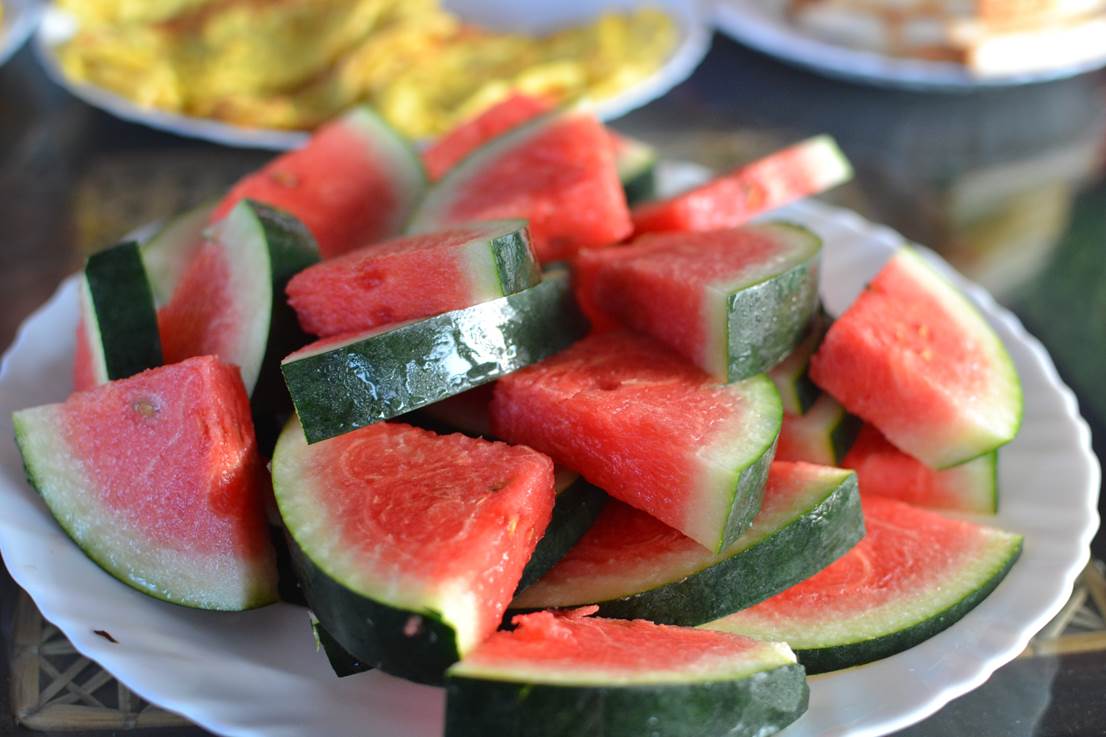
The food you eat and its effect on the body is a popular topic of conversation among westerners in India.
You’ll find you know more about the digestive systems of newly found friends than people you’ve known for years, with stocks of Imodium undergoing regular audits.
But toilet talk aside, food and drink does provide a great source of happiness, and also healing (post initiation stage).
Here are a few things I’ve learned and loved along the way, generally via two wheels:

Appreciate your food source and say thanks Keralan style
I get a veg box at home yet I’ve far greater appreciation for food where you can actually see its source. Breakfast mangoes from a tree you’ve spotted, fresh fish from the sea before your eyes. A single cashew nut coming from one cashew apple – hey, this is why they are so expensive in the UK. Tip: in Kerala show your gratitude with the banana leaf you’ve eaten off. Once you’ve finished your beautiful platter of relishes, nuts, fruit and curries, fold that leaf downwards to show you like it.

Variety is the spice of life
There are around 15 varieties of banana in Kerala ranging from the teeny finger-sized ones which decompose fast in your pocket to the pinky flat – and frankly huge – types, and the conjoined twins. There is no EU straight banana edict here.
Bread is also vast in its varieties. Parathas are my favourite – they are far softer and pull apart more easily than I’ve ever experienced elsewhere.

Less is best
This definitely applies to eating rich curries but Maria of Maria’s Cookery in Kochi (Cochin) explains that this is also so in spicing a curry in the kitchen. When doubling a recipe meant for two, don’t double the quantity of spice – just add a touch extra to get the same flavour, she says. I’d highly recommend checking out Maria’s classes. She is incredibly knowledgable with an emphasis on what’s good for you (ginger, lime juice, honey and water is a refreshing drink, recommended by Maria). You also get to eat the yum food afterwards!

Rehydrate as nature intended
Drinking fresh coconut juice (from the coconut, not an over-priced organic carton) is a great healer for the belly and generally to rehydrate. Similarly, a lime soda (fresh lime juice, soda water, salt and sugar) is perfect to rejuvenate yourself with after many hot hours on the bike. This is nature’s electrolyte drink and served widely across India. Also, just accept that watermelon tastes of onion. This is not some new variety of the fruit, rather everywhere seems to use the same knife to chop up both watermelon and onion. You get surprisingly used to it.

Long live and love the tuck shop!
The range of snacks you can buy at small roadside cafes is mindblowing. From the sweet shop style jars of cookies (spicy, of course, and sweet) to cabinets of fried bananas and vegetable samosas, there is pretty much something for everyone (including expiring kit-kats if desperate for a western sweet fix). Go for masala tea and accept that coffee will generally be instant, though it will take time to serve as they do make an effort with frothing the condensed milk. Yum, erm?

With very special thanks to talented (often while two-wheeling) photographer Sarah Michaux for most of the images used here.
These experiences were gained on a two-week cycle trip we shared, organised by Exodus travels with local guides.


Kelly
12 Apr 2016Fantastic pics and I loved the little nugget about the banana leaf. Wonderful reading as always Flavia Munn X
FlaviaMunn
12 Apr 2016Thanks, Kel! I can’t take credit for the pics but yes they are fab 🙂 x
Matt
13 Apr 2016Enjoyed this blog a lot and yes fantastic pics. All that wonderful food is making my mouth water.
Was there a ‘base’ mixture for the South Indian curries that they recommend? Also, was it hotter or milder than you expected? Or is it a case of depends on what you have.